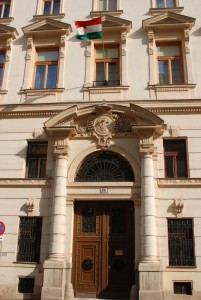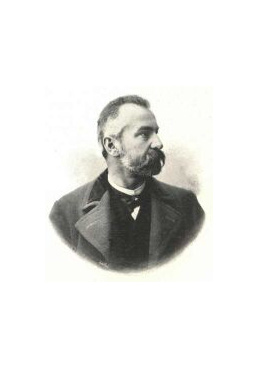THE BUILDING
The building of the Collegium Pázmáneum is a four-storey, neo-classical palace located in Boltzmanngasse, in the area known as Alsergrund in Vienna’s 9th district. It was built between 1902 and 1904 and is adjacent to the Consular Academy in which the Viennese Embassy of the United States of  America has been in operation since 30th June 1947. The Pázmáneum moved here in 1900 from the old building on Postgasse which proved to be too small. The construction was carried out during the time of rector Count Miklós Széchenyi (1898-1901), the rector himself playing an active role in the organization and, principally, in raising the requisi
America has been in operation since 30th June 1947. The Pázmáneum moved here in 1900 from the old building on Postgasse which proved to be too small. The construction was carried out during the time of rector Count Miklós Széchenyi (1898-1901), the rector himself playing an active role in the organization and, principally, in raising the requisi![]() te funds. Rector Széchenyi had experience in such large-scale works: the seminary in Győr (Hungary) was built during his time as bishop of Győr. To cover the cost of building the Pázmáneum, the Prince-Primate called for donations from the faithful. The construction lasted from the summer of 1899 until December 1900, when the fresco in the chapel’s sanctuary was completed. The four-storey u-shaped building has a small internal courtyard, a large rear garden, two staircases, more than 50 rooms, a refectory to accommodate 60 people, a state room and a chapel. Its designer, Győző Czigler, was a professor of the Faculty of Ancient Buildings at the Budapest Technical University
te funds. Rector Széchenyi had experience in such large-scale works: the seminary in Győr (Hungary) was built during his time as bishop of Győr. To cover the cost of building the Pázmáneum, the Prince-Primate called for donations from the faithful. The construction lasted from the summer of 1899 until December 1900, when the fresco in the chapel’s sanctuary was completed. The four-storey u-shaped building has a small internal courtyard, a large rear garden, two staircases, more than 50 rooms, a refectory to accommodate 60 people, a state room and a chapel. Its designer, Győző Czigler, was a professor of the Faculty of Ancient Buildings at the Budapest Technical University  and chairman of the Hungarian Association of Engineers and Architects. Besides his stylistic conservatism, Czigler was a disciple of the most modern theories in the field of technical solutions, and at the same time a zealous disseminator of those ideas. Czigler’s own words about the new building, which is today still standing and in use, are probably the best way to describe it. In a letter, the architect thus assured Prince-Primate Vaszary of the work: “In every part of the building sturdy materials and good equipment have been employed, chiefly in order to satisfy the requirements of practicability and durability.” Czigler was repeatedly accused of failing to make his buildings more diverse and creative. However, all of his buildings, including the Viennese house, can be said in all their parts to be the result of precise and careful work, well suited to the plan and also functional in the contemporary meaning of the word. Czigler was not only the designer of the building, but he also took charge of searching for appropriate “subcontractors” and organising their operation and payment. He supervised the whole course of the construction. The new building survived undamaged by the Second World War. As Antal Lepold, the rector at the time, stated in the 1947 edition of the Pázmánita Tudósító (the Pazmanite Reporter): “Thank God the building of the institute was spared from the storm of war.”
and chairman of the Hungarian Association of Engineers and Architects. Besides his stylistic conservatism, Czigler was a disciple of the most modern theories in the field of technical solutions, and at the same time a zealous disseminator of those ideas. Czigler’s own words about the new building, which is today still standing and in use, are probably the best way to describe it. In a letter, the architect thus assured Prince-Primate Vaszary of the work: “In every part of the building sturdy materials and good equipment have been employed, chiefly in order to satisfy the requirements of practicability and durability.” Czigler was repeatedly accused of failing to make his buildings more diverse and creative. However, all of his buildings, including the Viennese house, can be said in all their parts to be the result of precise and careful work, well suited to the plan and also functional in the contemporary meaning of the word. Czigler was not only the designer of the building, but he also took charge of searching for appropriate “subcontractors” and organising their operation and payment. He supervised the whole course of the construction. The new building survived undamaged by the Second World War. As Antal Lepold, the rector at the time, stated in the 1947 edition of the Pázmánita Tudósító (the Pazmanite Reporter): “Thank God the building of the institute was spared from the storm of war.”
The building
Designed by Elegant WordPress Themes | Powered by WordPress
